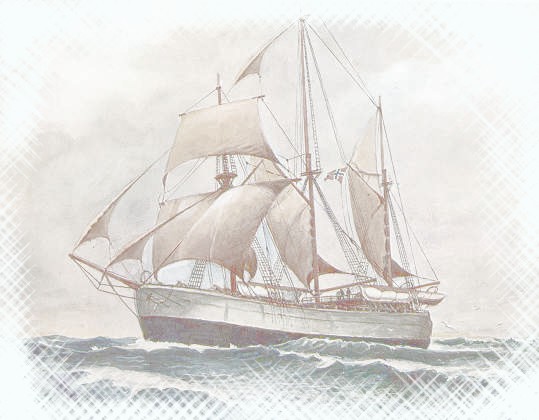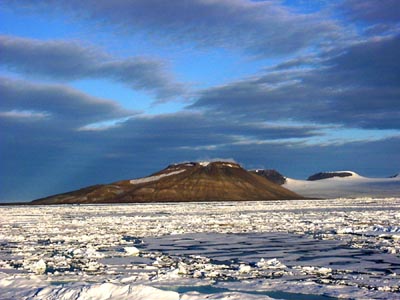"Fram" - is a famous polar vessel on which Fridtjof Nansen and R. Amundsen voyaged to the Polar Seas. Translation of "Fram" from Norwegian means "Forward".
The ship was built by the famous shipbuilder Colin Archer in Larvik, who together with Nansen planned and designed everything down to the smallest detail. Nansen decided to "build a vessel as enduring and as strong as possible". He wrote: "It shall be just big enough to carry supplies of coal and provisions
for 12 men for 4 years. A vessel of approximately 170 tons (gross) would probably be adequate. It will have an engine strong enough to be able to operate at a speed of 6 knots, but in addition will also have a full rig of sails….". Nansen believed that if ice floes could drift right across the polar area, an expedition must be able to use the same route. In order to do this, however, it was necessary to obtain a ship constructed in a way which would enable it to withstand the strain of becoming frozen fast in the ice. The ribs were made from strong wood and fixed additionally. 70-cm strong body consisted of three plankings. For the additional protection a vessel was covered by metal side plates from bow to stern, and there were rudder and screws, which can be drawn up. When the plan of expedition and the ideas of vessel construction were presented it was met with numerous objections. These only made Fridtjof Nansen even more determined and self-assured. He was not, however, unaffected by what the older experts had to say. Several good points of advice emerged, notably from experienced Norwegian seafarers, who new the dangers of the ice. A strong incentive to this plan was Nansen's earnest wish that it should be a Norwegian expedition that pioneered the way over the Polar Sea. He also hoped that the Norwegian flag would be the first to fly at the Pole. The many expeditions which had attempted to reach the Pole during the middle of the 19th century had all failed.
According to Nansen's requirements for the vessel construction she is to be forced out if it would be pressed by ice. So, the form of body was well-rounded. The vessel was built as three-master schooner of 39 m length, 11 m width, 420 tons displacement andwith steamer engine of 220 horsepower. Additionally a small windmill was mounted to develop electricity.
On the 24 June of 1983 the expedition departed and after one month left Norwegian waters turning eastwards from Vardoe. After sailed along the whole of the Northern Siberian coast, they reached the area around the New Siberian Islands at the end of September. It was here that the "Fram" froze fast in the ice. The construction proved itself to be correct, the vessel was pressed up onto the ice and in this way the lethal grip of ice which had crushed so many vessels previously, was averted. The slow passage across the Polar Sea began. On the 2 February they passed 80?N and the temperature was down to under - 50?C. On the 28 May the "Fram" reached 81? 34' N. At this position Nansen began to realize that they would not drift as far north as he had originally hoped nor would they drift over the actual pole point. The scientific investigations carried out each day on temperature, ocean currents, ice conditions, etc. were excellent, but to be the first to reach the North Pole was an increasingly temping challenge. Finally he made the courageous decision to attempt to reach the Pole on ski. He knew he could entrust the ship in Captain Otto Sverdrup's safekeeping and the crew had enough provisions of every kind to last them for years. He took with him Hjalmar Johansen and left the "Fram" on the 26 February of 1895. They lashed their equipment to six dog sledges and started. At the beginning of April Nansen realized that in all probability, it would be impossible to continue right to the point of the Pole. The ice conditions were too difficult. The return journey was, if possible, even more dramatic than the expedition northwards. On the 17 June of 1986 they came upon members of a British expedition which was on Franz Josef Land. Nansen and Johansen were received warmly by Frederick G. Jackson, leader of the British expedition. It was agreed that two Norwegians should accompany the British expedition ship to Norway. Such a long time had elapsed since the Fram expedition started, that many had begun to believe that the whole expedition had perished in the ice. There had, of course, been no possibilities for any form of communication with outside world since they became locked in the ice. Just after Nansen and Johansen arrived in Norway in August 1896, the news was received that the "Fram" too was safe. She had drifted for 1055 days across the Polar Sea towards Spitsbergen, and as soon as the ship had cleared the ice.
In 1898 "Fram" captained by Otto Sverdrup put out to the sea northwards through Smith Strait near the western coast of Greenland, Kane basin and along the northern coast of Greenland. But due to hard ice conditions was forced to winter near Sabine cape in the Smith Strait. Next year due to unfavourable ice conditions Sverdrup changed the course, and "Fram" entered to Jones Strait, in which the vessels didn't sail from the times of Baffin. Here she wintered thrice. From this place Sverdrup and two members of expedition made a trip on sledges toward the unknown western coasts of Ellesmere, Grinnell and Grant Lands and discovered and investigated an archipelago and Axel Heiberg, Amund Ringnes, EllefRingnes and Christiana islands. So, Sverdrup can add the discoveries made by Peary, Franklin and other voyagers, who participated in expeditions for Franklin search. In 1902 "Fram" again was cleaned from ice near the south-western coast of Ellesmere Land and set course for Norway. The "Fram" and her entire crew after 4-year voyage arrived in Norway only five days after Nansen and Johansen. An archipelago on the north of Canadian group of islands was named after Sverdrup.
Next expedition of "Fram" was performed by Roald Amundsen to discover the South Pole. On the 3 January of 1911 he and four members of expedition left "Fram" in the Bay of Whales in Ross Ice Barrier and started on dog-teamed sledges. After crossing successfully the ice plateau, clambering through glaciers on 3 thousand meters height (glaciers Axel Heiberg, Devil's Glacier) and successful sledding on ice of the Antarctic internal plateau Amundsen was the first who reached the South Pole on the 15 December of 1911. It was four weeks earlier than the expedition performed by R.F. Scott. On the return way, whichbegan on the 17 December, Amundsen discovered the Queen Maud Range of 4500 m height.On the 25 January of 1912 after 99 days returned to the "Fram". Before Amundsen had returned the other members of expedition explored the Antarctic Ocean. That is why the "Fram" became a vessel which sailed toward the most far North and the most farSouth. "Fram" sailed 84.000 sea miles that is equal to 2.5 circles of the Earth. In 1913 "Fram" was one of the first vessels which sailed through Panama Canal just opened for sailing. In 1916 A committee for collecting money and restoration of the vessel was organized. The money was collected, and in 1929 the "Fram" restoration started. In 1935 the vessel returned to Oslo. In 1936 a big house was built around "Fram" becoming a museum of the vessel (www.fram.museum.no ).







